Pond Weeds in Lakes & Farm Ponds - ID and Control - Hydrilla
Plant Profile and Control Recommendations
Hydrilla
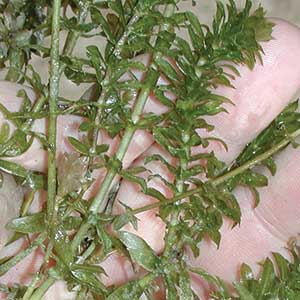
Hydrilla verticillatais is native to Asia, Africa, and Australia. In the US, hydrilla is an aggressively invasive aquatic weed that spreads readily and can produce a thick green mat.
- Hydrilla has pointed, bright green leaves about 5/8 inches long. Leaves feel scratchy from the spine or rib on the underside.
- Leaves grow in whorls of 3-10 along the stem; 5 is most common. Leaves have small teeth or serrations on the edges and at the tips, stems can grow to 25′ long
- Unlike similar looking plants, hydrilla has small, white to yellowish, potato-like tubers
- Hydrilla can grow aggressively, up to a foot a day. Early in the season, it grows horizontally along the bottom of the pond. Side shoots and new tubers can develop at the nodes as the plant grows. As the water temperature increases, the stems elongate, sending the shoot tips toward the water surface, creating a thick mat of vegetation. It can quickly shade out other aquatic plants.
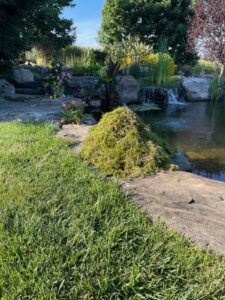
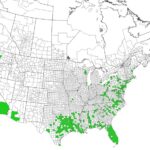
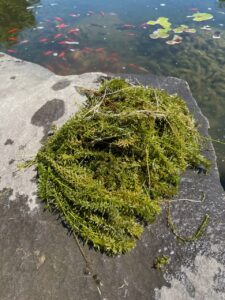
Hydrilla Control
Hydrilla is a tough, fast-growing weed with brittle stems that break easily, leaving fragments that can regrow. Manual removal might work for small infestations or in shallow areas, but it requires careful extraction of every last remnant of the entire plant, including leaves, roots and tubers, to prevent regrowth. Hydrilla spreads through fragments, so incomplete removal can worsen the infestation. Manual removal can be time-consuming and may not be effective at removing the underground tubers that can remain viable for years, making complete eradication difficult.
►If herbicide use is not permissible or available, manual removal is most effective in early spring when hydrilla is actively growing but hasn’t formed dense mats, and in shallow waters where you can access the roots.
Herbicide Application is most effective
Mixing Ultra PondWeed Defense with Treatment Booster Plus in a pump sprayer and applying underwater as close as possible to the leaves is the most effective solution.
Important Note: Ultra Pond Weed Defense is non-selective. It’s a contact herbicide (active ingredient: diquat dibromide) that will damage or kill almost any submerged or floating aquatic plants it touches, not just the target weed species. That means you need to apply it carefully to avoid harming desirable plants like water lilies or other ornamental aquatic plants.
Apply the herbicide only to areas with actively growing target weeds like hydrilla, and treat only 1/3 to 1/2 of the pond at a time to minimize oxygen depletion from decaying weeds, which can stress fish and other aquatic life.
Before applying Ultra PondWeed Defense, you may want to remove all other desirable plants and safe guard them elsewhere during the treatment. Typically after 5 days the residual levels of the active ingredient are low enough to avoid harming other plants.
Other plants that look like Hydrilla
→American elodea (Elobea spp) [Anacharis is an older name for the genus Elodea].

• Leaves in whorls of no more than 3
• Leaves are smooth
• No spines on the mid rib
• No tubers
• Native in the U.S.
→Southern naiad (Najas guadalupensis)
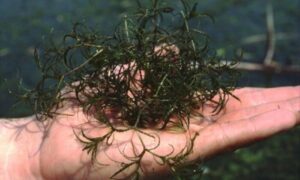
•Leaves are narrow , ribbonlike with broad base where they attach to stem
•Leaves are arranged in pairs, on opposite sides of stem
•Lead is tapered with small teeth
•Leaves are deep green to purplish green
Other Common Pond Weeds
Here’s a list of common pond weeds you’ll often see in the Northeastern U.S., broken down by type:
Submerged Weeds (grow mostly under water)
Hydrilla (Hydrilla verticillata) – non-native, aggressive, invasive, hydrilla closely resembles elodea, a native plant
Eurasian watermilfoil (Myriophyllum spicatum) – invasive, feathery leaves.
Coontail (Ceratophyllum demersum) – free-floating, forked leaves.
Pondweeds (Potamogeton spp.) – many native species with ribbon-like or broad leaves.
Curly-leaf pondweed (Potamogeton crispus) – invasive, crinkled leaves.
Floating-Leaved Plants
Yellow Floating Heart (Nymphiodes peltata) – Small (1-3″) thin, round or heart-shaped leaves, white or yellow flowers, look like mini water lilies
Floating-leaf pondweed (Potamogeton natans) – Floating leaves: Oval to oblong, leathery, with a distinct pointed tip, usually 2–5 inches long. Upper surface dark green, underside often reddish or purplish. Small, inconspicuous greenish-brown flower spikes held above the water surface
Free-Floating Plants
Duckweed (Lemna spp.) – tiny round leaves, covers surface quickly.
Watermeal (Wolffia spp.) – even smaller than duckweed, grainy texture.
Water hyacinth (Eichhornia crassipes) – invasive, purple flowers.
Emergent (Shoreline) Plants
Cattails (Typha latifolia, T. angustifolia).
Bulrushes (Schoenoplectus spp.).
Reed canary grass (Phalaris arundinacea).
Phragmites (Phragmites australis) – invasive reed.
